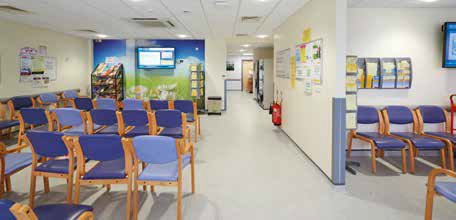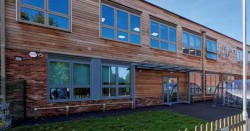The government needs to have a radical rethink when it comes to meeting the needs of today's building users. James Withey, Managing Director at Algeco Offsite, assesses the scale of the challenges and outlines a useful CPD to help.
Health, education and immigration all seem to be constantly in the news and not always for the right reasons. From the state of school and hospital buildings, through to lack of spaces to temporarily house people entering this country, we seem to be at a stage where the construction industry needs to embrace offsite.
Overcrowded classrooms, shortage of places and substandard teaching spaces are specific issues facing schools. Under the spotlight is reinforced autoclaved aerated concrete (RAAC), which was used to construct thousands of schools and hospitals between the 1950s and mid-1990s but is prone to failure. It is estimated that there are around 700,000 pupils in schools needing major repair.
Of equal concern is the fact that RAAC often exists in the same buildings as asbestos, because both materials were widely used in the postwar building boom. According to 'The Times' newspaper there are still 21,500 schools open today with asbestos, while 90% of Britain's 1,200 hospitals also contain it. Remediation or replacement of these buildings on any meaningful timescale can only be achieved by unlocking modern methods, a process that would also boost growth, create thousands of green jobs and address the specific challenges currently facing the market.
Seismic Platform
The Government has already stated that it has a preference for offsite, although with the scale of the challenges from RAAC alone, this really needs to be accelerated. Schools and hospitals require a quick solution before more people's health. We believe that the Seismic platform provides the way forward. Designed in line with the government's Construction 2025 targets, Seismic exceeds them in every way, delivering a building that is 75% faster to complete, 70% lower in carbon impact and 47% better value than traditional construction. The standardisation developed for the platform even allows Seismic to compete with other modular solutions, with an improvement of around 30% on speed.
This transformational efficiency means that it offers a solution for other sectors, too, for example, rapid accommodation for the thousands of people entering the country and having to be housed in expensive hotel accommodation. A situation that is both expensive and far from ideal in terms of safety.
All this is one of the reasons why we're carrying out a new £3.5million capital investment from Modulaire Group to extend our Carnaby facility in East Yorkshire. It will increase production capacity by up to 70% and create more new permanent jobs. Sustainability and low carbon are at the core of the new investment programme, which incorporates solar PV, recycling, energy efficiency and low carbon initiatives. Our goal is to create a low carbon production facility. This investment to expand the offsite business complements our strategic plan for sustainable growth, which the Modulaire Group has been implementing in recent years.
This new capital investment represents a significant step and reflects how our offsite business has grown over the last few years. Investment will significantly increase capacity whilst contributing to our journey of being a low carbon business. Our offsite business is in a period of rapid growth and expansion, delivering some truly exceptional projects, whilst pushing the boundaries of R&D and innovation. We like to think that we have a solution for the issues discussed here.


CPD: How to design for offsite construction
With multiple sector and building performance challenges it is important for building specifiers to stay relevant and up to date on new industry trends and practices. As the expectations of each construction project becomes ever more demanding, a process that is pushing offsite construction to the forefront, it is becoming more important than ever for architects to really know the ins and outs of different construction methods. In terms of offsite and modular systems, the CPD walks participants through the process, starting at early design stage, through to construction, modular manufacture and, to for life of the building.
'Form Follows Function – How to Design for Offsite Construction' is the title of our new CPD presentation that looks to provide these essential insights. It has been certified by the CPD Certification Service, the world's leading and largest independent CPD accreditation organisation working across all industry sectors. Our CPD presentation is designed to support industry professionals on what offsite construction can do to help them meet their building performance targets, while still utilising MMC to build safe, efficient and striking structures.
The CPD format uses a Design for Manufacture & Assembly (DfMA) overlay to the conventional Plan of Work to highlight the differences between offsite and traditional construction and the benefits that they create. Early engagement, collaborative working, clear accountability and strong project management are consistent themes of our offsite approach.
The CPD is supported with detailed case studies from leading architects. These illustrate where offsite construction has been used successfully, whilst a Q&A section tackles the questions commonly asked such as fire safety and planning – all selected to share knowledge. In addition, the CPD covers the features and sustainability benefits of offsite construction – a key requirement with a growing number of architects and specifiers – before finishing with practical guidance on design considerations and how building performance can be optimised further.
By the end of the CPD presentation, which we are delivering through online sessions, specifiers will have a greater understanding of modular construction. They will also gain a technical and practical understanding of the benefits of offsite and modular construction as a whole and feel confident about specifying largescale projects using this technique. Sustainability is embedded in our approach and is fundamental to everything we do as a company. This vision is based on the principle that the brand must do social and environmental good.
Making Offsite Count and Debunking Myths
We have developed our new CPD specifically for architects and specifiers looking to help their clients access the benefits of modular and offsite construction – alongside elements of economic and environmental, social and governance (ESG). It offers a better understanding of the benefits of specifying offsite to meet with the most up to date building performance requirements.
We encourage specifiers to take up the opportunity offered by our seminars. They are a great place to ask expert advice for any on-going or future project. As a leading manufacturer our team know their product inside out. We're keen to help industry colleagues learn more about offsite solutions - and explode the odd myth along the way. Our CPD will ensure confidence when specifying offsite construction.









